Assessing Outdoor Air Near Schools
Chicora Elementary School - North Charleston, SC
Results and Analysis of EPA’s monitoring
EPA selected this school for monitoring because it is located near industrial sources, maritime activities, and major roadways which are all sources of air toxics emissions. Computer models were used to determine which air toxics may be present at elevated levels in the outdoor air near the school. These models showed that acrolein, acetaldehyde, benzene, 1,3-butadiene, manganese, nickel, and hexavalent chromium could be present in the air around the school and prompted EPA to test to see if the levels present may be of concern.
| Primary Findings | Levels of manganese, nickel, and hexavalent chromium in the air at the school are below levels of health concern for short-term and long-term exposure. Levels of acetaldehyde, benzene and 1,3-butadiene in the air are below the levels of concern suggested by the modeling information. Although they are below levels of concern, these results indicate the influence of mobile source pollutants of concern that are the focus of EPA actions nationwide. Results of a recent short-term laboratory study have raised questions about the consistency and reliability of monitoring results of acrolein. As a result, EPA will not use these acrolein data in evaluating the potential for health concerns from exposure to air toxics in outdoor air as part of the School Air Toxics Monitoring project. |
| Key Pollutants Monitored | Manganese. Inhalation may affect the nervous system if people are exposed to high levels. |
| Next Steps | Based on the analysis described here, EPA will not extend air toxics monitoring at this school. However, EPA remains concerned about stationary source and mobile source emissions of air toxics, and continues to work to reduce those emissions across the country, through national rules and by providing information and suggestions to assist with reductions in local areas. The South Carolina Department of Health and Environmental Control (DHEC) will continue to oversee industrial facilities in the area through their air permits and other programs. DHEC will work with local governments, schools and others to implement voluntary programs for reductions in mobile source emissions. |
Summary of Study Approach and Findings
Approach:
- A monitor collected air samples from July 18, 2009 through March 2, 2010 at Chicora Elementary School in North Charleston, South Carolina.
- We posted individual air sample results on this website throughout the monitoring period to keep your community informed during the monitoring period.
- During the monitoring period, we evaluated the monitored concentrations to see if there was a health concern from short-term exposures (e.g., several weeks).
- When the monitoring was complete, we analyzed the results to see if there was a health concern from long-term exposures (over a lifetime).
- Also, when the monitoring was complete, we evaluated all the air samples from the on-site monitor. We also evaluated information on wind speed and wind direction from a weather monitor at the school, along with historical weather information and information about nearby source(s) of manganese, nickel, hexavalent chromium, acetaldehyde, benzene, and 1,3-butadiene.
Findings:
- Our analysis found that levels of manganese, nickel, and hexavalent chromium in the air at the school are below levels of concern for long-term exposure.
- Measured levels of acetaldehyde, benzene, and 1,3-butadiene and associated longer-term concentration estimates are below the levels of concern suggested by the modeling information available prior to monitoring. Although they are below levels of concern, these results indicate the influence of mobile source pollutants of concern that are the focus of EPA actions nationwide.
- Results of a recent short-term laboratory study have raised questions about the consistency and reliability of monitoring results of acrolein. As a result, EPA will not use these acrolein data in evaluating the potential for health concerns from exposure to air toxics in outdoor air as part of the School Air Toxics monitoring project.
- Acetaldehyde, benzene and 1,3-butadiene are common in the outdoor air in urban areas where many sources are located near one another, particularly mobile sources such as cars and other motor vehicles and off-road machinery. Levels of acetaldehyde, benzene and 1,3-butadiene in many urban areas can be higher than in more rural areas. EPA remains concerned about mobile source emissions and continues to work to reduce those emissions across the country, through national rules and by providing information and suggestions to assist with reductions in local areas.
- The process to identify schools for monitoring relied on emissions estimates and other information. Ambient air monitoring at the school allowed measurement of what was actually in the air.
- Information from the nearby sources of manganese, nickel, and hexavalent chromium indicates that the facilities were operating at a rate between 60-80% of their production capacity during the sampling period.
- The most recently available manganese, nickel, and chromium TRI emissions data (2008 TRI) for one of the maritime support facilities (marine containers) are lower than the 2005 TRI emissions.
- The most recently available acetaldehyde, benzene, and 1,3-butadiene emissions estimates for the nearby roadways and maritime activities from the 2005 National-Scale Air Toxics Assessment (NATA) are lower than the estimates used to identify this school for monitoring
- Based on the analysis summarized here, EPA will not extend air toxics monitoring at this school.
- Click here for additional information
How We Analyzed the Information We Collected at this School
The analysis considered whether the information collected at the school might raise concerns for the health of children or adults at the school. We looked at the following types of information:
- Measured manganese, nickel, hexavalent chromium, acetaldehyde, benzene, and 1,3-butadieneconcentrations and information on manganese, nickel, hexavalent chromium, acetaldehyde, benzene, and 1,3-butadiene
- Measured wind direction and wind speed at the school
- Information about nearby sources of manganese, nickel, hexavalent chromium, acetaldehyde, benzene, and 1,3-butadiene
Analysis of Measured Manganese Concentrations:
1. Calculate the average: We calculated the average of the manganese measurements (shown by the black diamond in the graph below). We compared this average to the long-term comparison level (thick line on the graph below). The long-term comparison level represents the level of manganese in the air that is below levels associated with health concerns, even if someone breathed air containing manganese at that level all day, every day over their lifetime.
Result: The average manganese level for the samples collected was well below the long-term comparison level. The health concern is low.
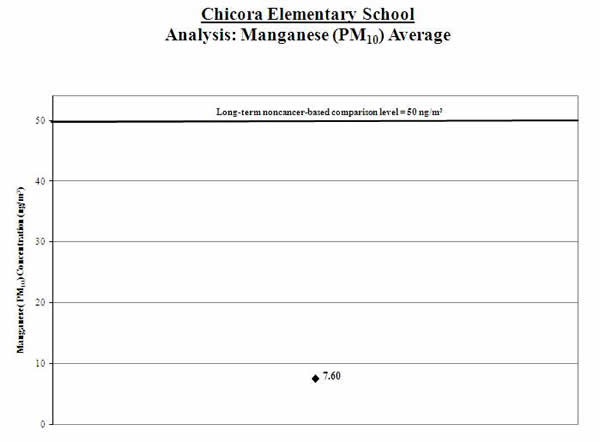
2. Calculate a range: To account for varying air concentrations of manganese, we calculated a range around the average. We did this by estimating high and low values that the longer-term concentrations might reach using common statistical tools. We compared the highest point in the range (called the “upper bound”) to the long-term comparison level.
Result: The high end of the range is lower than the comparison level. The health concern is low.
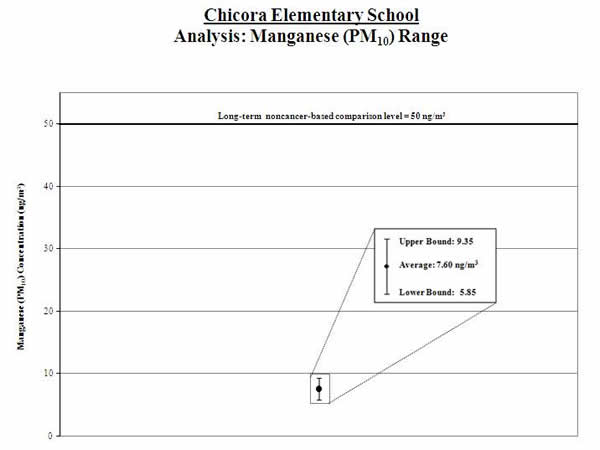
Analysis of Measured Nickel Concentrations:
1. Calculate the average: We calculated the average of the nickel measurements (shown by the black diamond in the graph below). We compared this average to the long-term comparison levels (values at the top of the graph below).
Result: The average nickel level for the samples collected was well below the long-term comparison levels. The health concern is low.
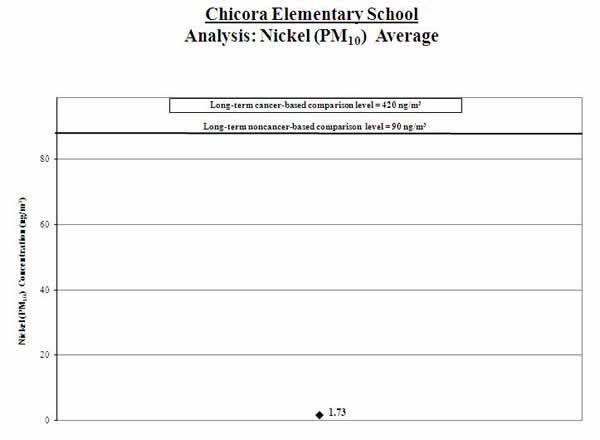
2. Calculate a range: To account for varying air concentrations of nickel, we calculated a range around the average. We did this by estimating high and low values that the longer-term concentrations might reach using common statistical tools. We compared the highest point in the range (called the “upper bound”) to the long-term comparison levels.
Result: The high end of the range is much lower than the comparison levels. The health concern is low.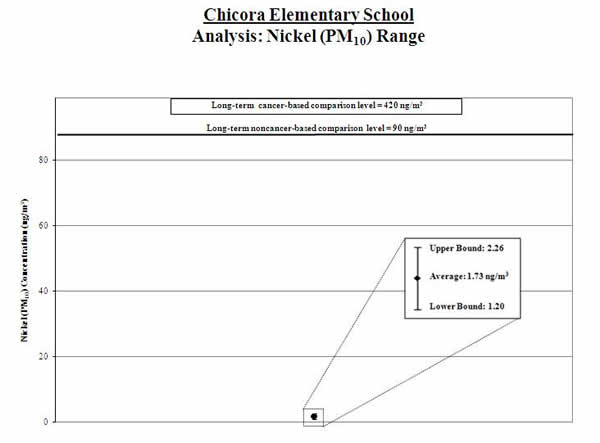
Analysis of Measured Hexavalent Chromium Concentrations:
1. Calculate the average: We calculated the average of the hexavalent chromium measurements (shown by the black diamond in the graph below). We compared this average to the long-term comparison levels (see thick line on the graph below).
Result: The average hexavalent chromium level for the samples collected was well below the long-term comparison levels. The health concern is low.
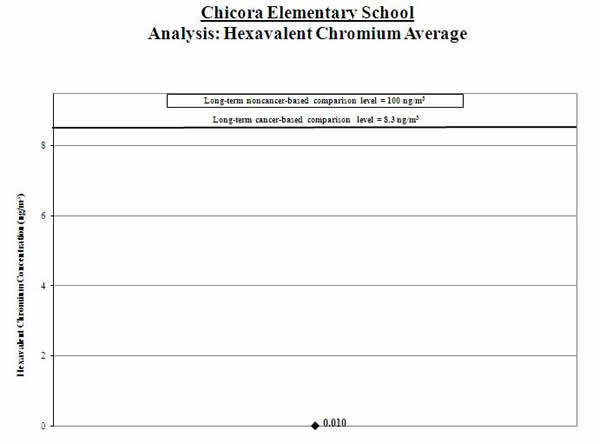
2. Calculate a range: To account for varying air concentrations of hexavalent chromium, we calculated a range around the average. We did this by estimating high and low values that the longer-term concentrations might reach using common statistical tools. We compared the highest point in the range (called the “upper bound”) to the long-term comparison levels.
Result: The high end of the range is much lower than the comparison levels. The health concern is low.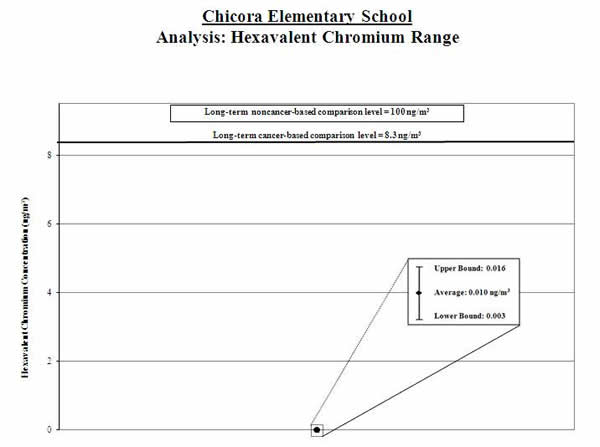
Analysis of Measured Acetaldehyde Concentrations:
1. Calculate the average: We calculated the average of the acetaldehyde measurements (shown by the black diamond in the graph below). We compared this average to the long-term comparison level (thick line on the graph below).
Result: The average acetaldehyde level for the samples collected was well below the long-term comparison levels.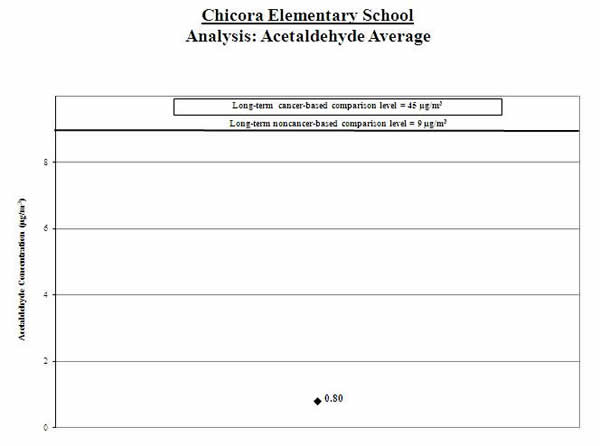
2. Calculate a range: To account for varying air concentrations of acetaldehyde, we calculated a range around the average. We did this by estimating high and low values that the longer-term concentrations might reach using common statistical tools. We compared the highest point in the range (called the “upper bound”) to the long-term comparison level.
Result: The high end of the range is lower than the comparison levels.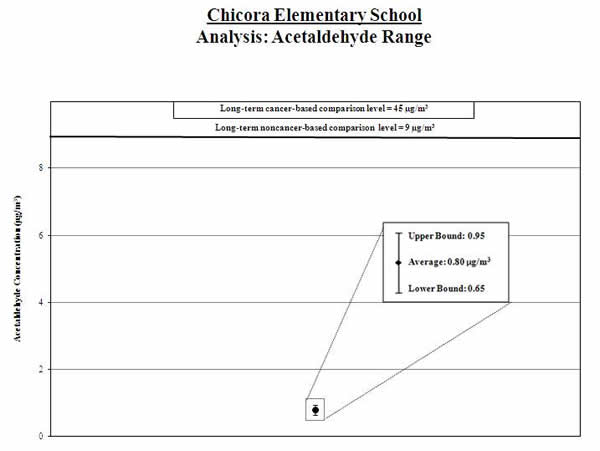
Analysis of Measured Benzene Concentrations:
1. Calculate the average: We calculated the average of the benzene measurements (shown by the black diamond in the graph below). We compared this average to the long-term comparison level (thick line on the graph below).
Result: The average benzene level for the samples collected was below the long-term comparison levels.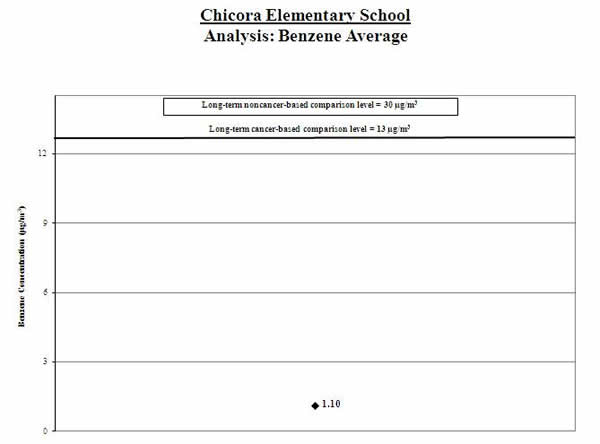
2. Calculate a range: To account for varying air concentrations of benzene, we calculated a range around the average. We did this by estimating high and low values that the longer-term concentrations might reach using common statistical tools. We compared the highest point in the range (called the “upper bound”) to the long-term comparison levels.
Result: The high end of the range is lower than the comparison levels.
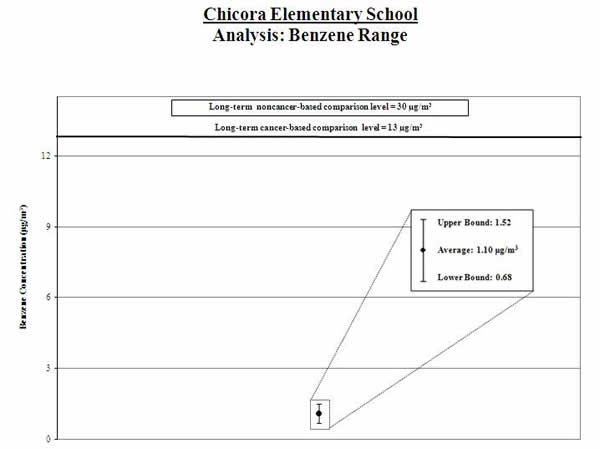
Analysis of Measured 1,3-Butadiene Concentrations:
1. Calculate the average: We calculated the average of the 1,3-butadiene measurements (shown by the black diamond in the graph below). We compared this average to the comparison level (thick line on the graph below).
Result: The average 1,3-butadiene level for the samples collected was well below the long-term comparison levels.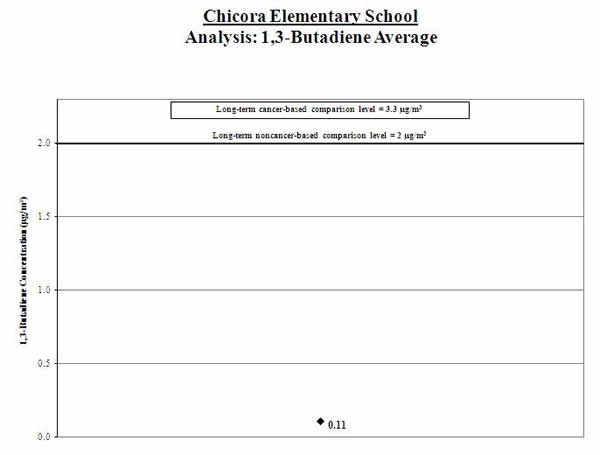
2. Calculate a range: To account for varying air concentrations of 1,3-butadiene, we calculated a range around the average. We did this by estimating high and low values that the longer-term concentrations might reach using common statistical tools. We compared the highest point in the range (called the “upper bound”) to the long-term comparison level.
Result: The high end of the range is lower than the comparison levels.
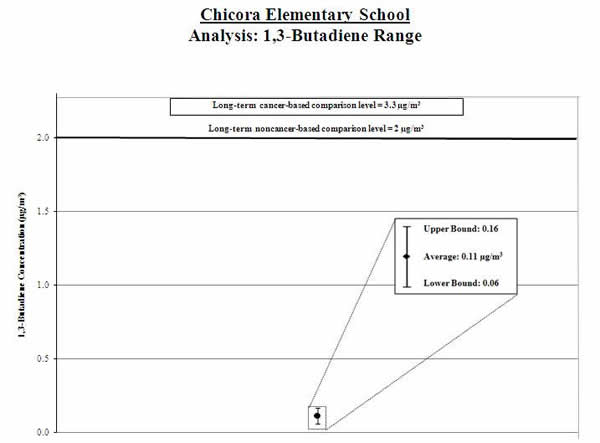
Analysis of Measured Wind Direction and Wind Speed at the School
We took measurements of wind direction and speed every day during the sample period. We took special note of the wind speed and direction on the days we took measurements of manganese, nickel, hexavalent chromium, acetaldehyde, benzene, and 1,3-butadiene.
| What we looked at | What we found |
| We looked at whether the wind data taken on the days we took measurements of manganese, nickel, hexavalent chromium, acetaldehyde, benzene, and 1,3-butadiene are similar or different from the wind patterns during the entire sampling period. | We found the wind patterns taken on the days we took measurements of manganese, nickel, hexavalent chromium, acetaldehyde, benzene, and 1,3-butadiene to be generally similar to those observed during the entire sampling period. |
| We looked at whether the wind pattern during the sampling period is reflective of regional wind pattern over the long term. | Although we lack long-term wind data at the monitoring site, the wind pattern at the NWS station during the sampling period is very similar to the historical long-term wind flow pattern at that same NWS station. This information, along with the wind flow patterns at the school, suggest that the sampling period is representative of year-round wind patterns on a regional scale. |
Analysis of Information on Nearby Sources of Manganese, Nickel, Hexavalent Chromium, Acetaldehyde, Benzene, and 1,3-Butadiene Emissions
| What we looked at | What we found |
| Whether we could determine if the sources were operating as usual during the sampling period | Information from the nearby sources of manganese, nickel, and hexavalent chromium indicates that the facilities were operating at a rate between 60-80% of their production capacity during the sampling period. There were no disruptions in typical maritime activity or roadway activity during the sampling period. |
| The concentrations of manganese, nickel, hexavalent chromium, acetaldehyde, benzene, and 1,3-butadiene measured at the school are lower than those suggested by the information that helped identify this school for monitoring. | |
| The nearby sources of manganese, acetaldehyde, nickel, and hexavalent chromium have air permits issued by DHEC that include operating requirements. DHEC will work with local governments, schools, and others to implement voluntary programs for reductions in mobile source emissions. |
Additional Information
Technical Report for School: Assessing Outdoor Air Near Schools: Chicora Elementary School (North Charleston, SC) (PDF) (48pp, 940k). The technical report is geared toward risk assessors, risk managers, and other regulatory agencies.
Background on School Monitoring Effort
